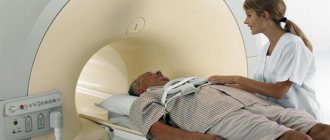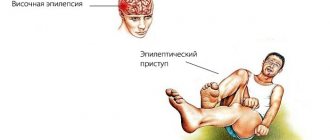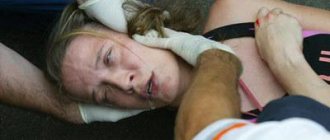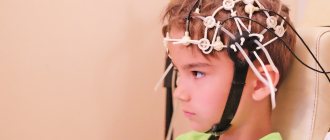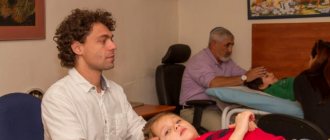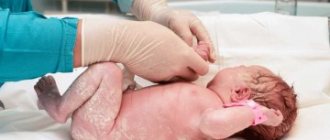General information
An epileptic seizure is a disease that is accompanied by sudden convulsive contractions that cause a person to lose consciousness and fall to the floor. Such attacks occur as a result of the development of epilepsy. However, not only epilepsy can cause such convulsive contractions, but also some concomitant diseases. For example, meningitis, encephalitis or other neuroinfections.
If we say that epileptic seizures necessarily cause terrible muscle contractions, then this is far from true and usually the seizures are non-convulsive.
Classification of seizures
Spasms are divided into tonic or clonic. In the first case, the attack is accompanied by prolonged painful muscle tension. In the second, the muscles tense periodically, as if in a jerky manner. In some cases, tonic-clonic seizures appear, combining two manifestations.
According to pathogenesis, the following types are distinguished:
- Repercussive seizures (associated with segmental damage to the structures of the central nervous system);
- Reflex;
- Ischemic (caused by lack of oxygen);
- Hysterical (associated with central nervous system overstrain);
- Hormetonic (caused by brain disease).
The spasm can be local (on the leg, arm, face) and generalized. Local convulsions often occur as spasms. They affect not only skeletal muscles, but also the smooth muscles of internal organs. Classification:
- Spasm of the muscles of the arms, legs, torso;
- Fibrillations (spontaneous local muscle contractions);
- Spasm of the sphincters of internal organs (cardiospasm, pylorospasm).
In ICD 10 the following classification of convulsive syndrome is found:
| R 56 | Convulsions not elsewhere classified Excluded: convulsions and paroxysmal seizures, epilepsy and pathology of infants |
| R 56.0 | Cramps with fever |
| R 56.8 | Other specified seizures |
Types of seizures
There are several types of seizures, including:
- Generalized.
- Focal (partial).
In turn, generalized ones are divided into:
- tonic-clonic;
- absence seizures;
- myoclonic;
- atonic (akinetic).
Focal ones also have a classification:
- Simple.
- Complex.
Based on the nature of their manifestations, focal seizures are divided into:
- sensory (sensitive);
- motor (motor);
- gelastic (uncontrollable attack of laughter or crying);
- reflex;
- secondary generalized.
A special type of seizure is status epilepticus.
A few facts about the disease
Status epilepticus is a condition when a person does not recover from a convulsive seizure, which is repeated cyclically for a long time.
Depending on the type, the signs of an epileptic seizure differ.
Tonic-clonic
Tonic-clonic generalized seizures are clear representatives of a classic epileptic seizure, which includes the patient losing consciousness, convulsing and foaming.
This condition begins abruptly with the patient falling to the floor, rolling up the eyeballs and arching the whole body. This happens as a result of tension throughout the muscles. This condition causes the patient to scream loudly. This phase lasts no more than 20 seconds and is called tonic.
The second phase (clonic) is a rhythmic jerking of the limbs and the whole body in a spasm. The intensity of muscle contractions and their strength are great, so you should not try to hold the patient’s legs or arms, it is useless.
Gradually, the frequency of twitching decreases, and the patient freezes, a relaxation phase begins. By the way, this phase is characterized by urinary incontinence or uncontrolled bowel movements. A person falls asleep for a short period of time, and after waking up he will not remember anything that happened.
In the event that the twitching does not subside for more than five minutes, it is necessary to call an ambulance, because we are already talking about status epilepticus, and only a doctor can remove it and the epileptic needs to go to the clinic for an examination and a detailed examination of the body.
In addition to the above symptoms, the generalized tonic-clonic form is characterized by:
- blood pressure surges;
- grimacing;
- deviations of the eyeballs;
- holding your breath;
- tongue biting;
- clenching teeth.
Absence seizures
This form of the disease belongs to a subtype called epilepsy without seizures. Absence seizures are characterized by a complete loss of consciousness in the patient and an almost complete absence of uncontrolled motor activity. As a rule, such attacks last no more than 20 seconds and are considered simple.
As for complex absence seizures, motor and tic manifestations are added to the usual symptom of blackout of the patient, including:
- automatic, repetitive acts of swallowing or licking lips (reminiscent of a nervous tic);
- clonic twitching of the limbs;
- rapid pulse;
- facial redness;
- dilated pupils;
- uncontrolled urination.
Very often, this type of disease is confused with focal symptomatic epilepsy precisely because of the presence of accompanying symptoms.
Myoclonic
There are two subtypes of myoclonic seizures:
- Independent.
- Myoclonic absence seizures.
Independent ones have nothing to do with epilepsy and can manifest themselves as a result of the progression of various diseases (multiple sclerosis, stroke).
Myoclonic generalized seizures are characterized by the fact that during convulsive contractions, the muscles of the face or limbs (both upper and lower) are involved in the process.
In turn, absence seizures are complemented by loss of consciousness for a short period of time.
The patient does not necessarily fall with this type of seizure; he can either simply bend his knees, as if he was lightly hit on the knee area from the back side, or lose his balance and fall from surprise. One person in ten loses their balance.
Atonic
This seizure is similar to an absence seizure. Why is this happening? The point is the complex structure of the brain, and in order for the doctor to make the necessary diagnosis, he has to thoroughly study everything (not just the patient’s medical history).
So, an atonic seizure occurs:
- Short.
- Prolonged.
The difference in these two types is the duration. The short one ends in a few seconds, and the prolonged one can last up to several minutes. The descriptions of the two types of disease are similar. Thus, a person’s muscle tone weakens, resulting in the head falling onto the chest, as well as the body falling to the ground.
In most cases, the sick person simply lies on the ground, motionless. Sometimes convulsive, short contractions, psychomotor and autonomic disorders are added to the symptoms.
The danger of the disease is that the patient may suffer a traumatic brain injury (TBI).
Atonic seizures are often confused with ordinary fainting as a result of overwork or another reason.
Touch focal
These attacks occur as a result of the formation of foci of increased neural activity in the parietal and occipital lobes of the cerebral cortex. The definition of sensory includes what signs may indicate the development of a given seizure.
For example, if the focus of activity affects the part of the brain responsible for visual images, the patient may see hallucinations (bright round objects, an inverted image of his own body, some scenes from life). When this happens for the first time, the patient does not even think about epilepsy and only a doctor can make the correct diagnosis. When the parietal part is affected, the patient begins to experience sensory disorders in the form of feelings of coldness, numbness, tingling, burning, etc.
Similar symptoms develop in alcoholic epilepsy, when an alcoholic, while consuming large amounts of alcohol, begins to feel irreversible changes in the body.
As for the temporal cortex, the emergence of foci of activity in it can be associated with the following manifestations:
- auditory hallucinations (grinding, voices, ringing);
- dizziness;
- illusory manifestations.
Also, the sensory type of the disease can manifest itself in the form of a feeling of metal, bitterness, acidity or saltiness in the mouth, nausea, etc.
Motor focal
Motor focal seizures are seizures that are characterized by jerking in one or more areas. Motor epilepsy includes the Jacksonian type of disease (Jacksonian seizures). They can occur in both infants and adults. They can manifest themselves in the form of nervous tics of the following nature:
- chewing;
- smacking;
- swallowing;
- grasping movements with the hand.
There are also attacks of violent automatisms, which are:
- movements simulating boxing;
- cycling;
- circular pelvic movements;
- motor seizures can occur with alcoholism.
Gelastic
These attacks are not identified as a separate form and are often classified as symptoms of one of the above types of disease. The occurrence of uncontrollable crying or laughter can develop both at night and during the day. This attack does not manifest itself in any other way, the only thing is that some patients complain of poor sleep in the presence of such abnormalities.
Also, this form has the least consequences.
Secondarily generalized
This type begins its development as a normal sensory or motor subtype of focal epilepsy, but as a result of a number of reasons they transform into a normal generalized seizure. In this situation, it is necessary to understand that the treatment may differ slightly, and it is important to make the correct diagnosis.
Clinical picture
Localization of seizures can cover any area. Most often they appear in the muscles of the lower extremities and are caused by vascular and neurological disorders. The painful spasm of the chewing muscles that occurs with tetanus is called trismus.
In the area of internal organs, spasm is most often localized in the area of sphincters - muscles that ensure the movement of fluids through hollow organs. For example, cardiospasm of the esophagus, terminal stomach (pylorospasm), spasm of the biliary sphincter (Oddi) are distinguished.
Convulsions appear suddenly, without precursors. Some types of crampy are characterized by a certain history. For example, the occurrence of symptoms during sleep or in the morning when waking up, overexertion or intense training the day before. Convulsive syndrome is not characterized by loss of consciousness. As a rule, attacks are accompanied by severe pain, which persists in the muscle afterward.
Generalized seizures are characterized by the influence of a causative factor (fever, alcohol, etc.). As a rule, they are accompanied by loss of consciousness and the appearance of general neurological symptoms.
During an attack, somatic symptoms may appear: increased blood pressure, vomiting, headache, foam at the mouth. This may result in involuntary urination or defecation. Complications include injuries, tongue biting and transition to status, respiratory arrest.
Convulsive syndrome in children and adults
| Children | Adults |
| Causes: Fever, trauma, metabolic disorders “fifth day cramps” | Infection, intoxication, brain diseases |
| Clinic: More often generalized, severe | Can be local and generalized, the clinic depends on the cause |
| How they go: Most often they stop on their own | Local ones go away on their own, generalized ones require medical attention |
Epileptiform seizures
There is a special type of seizures called epileptiform seizures (EP). This subtype has nothing to do with epilepsy. There are several varieties. Including:
- Hysterical.
- Fainting.
- Painful.
You can list for quite a long time the reasons that provoke seizures. For example, a baby’s nervous system is not fully formed, and even a simple rise in temperature or teething can trigger convulsions. But this is not an epilepsy attack, but such a reaction of the body.
Another variant of seizures is a violation of the blood supply to the brain. For example, a tumor grows in a person’s brain or there is swelling and at one point the blood supply is suddenly cut off. The patient faints and may develop convulsions. A distinctive feature of such EP is its vegetative manifestation (the face becomes pale, and with epilepsy it turns red).
Seizures
An epileptic seizure is a brain reaction that disappears after the root causes are eliminated. At this time, a large focus of neural activity is formed, which is surrounded by a containment zone, like the insulation of an electrical cable.
The extreme nerve cells do not allow the discharge to go throughout the brain as long as their power is sufficient. When it breaks through, it begins to circulate throughout the surface of the cortex, causing a “blackout” or “absence seizure.”
Experienced doctors know how to recognize epilepsy. In a state of absence seizure, the epileptic withdraws from the surrounding world: he becomes abruptly silent, concentrates his gaze on the spot and does not react to the environment.
Absence lasts a couple of seconds. When a discharge hits the motor zone, a convulsive syndrome appears.
The epileptic learns about the absence form of the disease from eyewitnesses, since he himself does not feel anything.
Therapeutic tactics for epilepsy
Typically, for people suffering from epilepsy, first aid for an epileptic seizure may be required, which includes the following algorithm of actions:
- Do not try to hold the twitching limbs, you will either damage them or injure yourself.
- Place something soft under convulsing limbs and body parts to minimize injury.
- Turn the patient on his side to prevent him from choking on foam or vomit.
- If possible, insert a soft material (not hard) into the epileptic's teeth to prevent tongue biting, however, if the teeth are already clenched, do not try to unclench them.
If a person enters a state of status epilepticus, the patient will require emergency medical care, which involves the administration of a special medication intramuscularly. The drug is selected individually, as is its dosage.
Treatment of the disease must be carried out under the supervision of a specialist and follow his recommendations.
An epileptic seizure is a rather strange phenomenon for the human body and its appearance can be provoked by any seemingly insignificant phenomenon (adenoid, shaking the head or bright light), so you should treat your body with care, especially if you are diagnosed with epilepsy.
What to do during an epileptic seizure and how to deal with it can be read in this article.
Diagnostics
Diagnosis of convulsive syndrome depends on its location and severity. For generalized seizures, hospitalization in a hospital is recommended to clarify the etiology of the disease. For local cramps (cramps in the calf muscles), some clarifying studies are required.
Non-instrumental diagnostics
The doctor must collect anamnesis and conduct an objective examination of the patient. A convulsive attack is characterized by a connection with an underlying painful condition (trauma, infection, tumor, endocrine disorders).
It is necessary to check with the patient whether he is taking medications. Many of the drugs provoke generalized and local seizures. We list their names in the table below.
| Diuretics | Irbesartan | Medicines that cause seizures during “withdrawal syndrome” |
| Oral contraceptives | Valsartan | Alcohol |
| Pyrazinamide | Clofibrate | Barbiturates |
| Stimulants (nicotine, caffeine, amphetamine) | Lovastatin | Benzodiazepines |
| Vincristine | Donepezil | Sedatives |
| Bronchdilators | Cisplatin | Sleeping pills |
Further, laboratory data can become an important clinical indicator. The level of glucose, magnesium, calcium, urine analysis, and arterial blood gas composition are determined. To detect neuroinfection, a lumbar puncture is necessary. The quality of the cerebrospinal fluid determines the presence of an inflammatory reaction caused by a virus or bacteria.
| Tests for seizures |
| General blood |
| Biochemical analysis |
| Electrolytes |
Attention! Local convulsions (cramps, spasms of the upper extremities) are often a manifestation of other painful conditions. For example, if the calf muscles are affected, it is recommended to perform ultrasound of the vessels of the lower extremities and electromyography. If the shoulder muscles are affected, it is necessary to exclude diseases of the cervical spine (X-ray, MRI).
Instrumental diagnostics
An EEG can give the doctor an idea of whether there is an abnormal seizure pattern in the brain. This symptom is characteristic of epilepsy. Therefore, any generalized seizure of unknown etiology is an indication for electroencephalography.
Imaging techniques can help make the diagnosis easier. In some cases, seizures are caused by oncology or inflammatory diseases of the brain or spinal cord. Only CT and MRI can determine the exact location of the problem and associate it with the occurrence of the syndrome. The decision to prescribe the study is made by the attending physician.
Differential diagnosis
Convulsive syndrome can accompany some dangerous conditions. It is necessary to carry out timely diagnosis in order to identify the causes of the disease and begin treatment immediately.
- Neuroinfections
| Encephalitis, meningitis, myelitis | Accompanied by the manifestation of meningeal signs, focal neurological symptoms (loss of motor or sensory innervation in a certain area), loss of cranial nerve function | A lumbar puncture is necessary to clarify the diagnosis. |
- Hypoglycemia
| History of diabetes mellitus, constant use of insulin | Anxiety, tremor, tachycardia, pallor, hunger, nausea, weakness, disorientation, double vision | Glucose level below 2.77 mmol/l |
- Hypocalcemia
| History of disease and/or surgery on the thyroid and parathyroid glands | Tonic convulsions, + Chvostek's symptoms, Trousseau's, smooth muscle spasm, | Calcium below 1.75 mmol/l Phosphate above 1.08 mmol/l An ECG is required |
- Magnesium deficiency
| Characteristic of alcoholism + malnutrition, after severe intestinal surgery (malabsorption) | Long-term therapy with loop diuretics, a history of chronic kidney disease, taking gentamicin, tobramycin, amikacin, cyclosporine | Serum magnesium less than 1 mEq/L Hypocalcemia, decreased vitamin D Changes on the ECG |
- Vascular pathologies of the brain
| Aneurysm, stroke, malformation | There are general cerebral symptoms before and after the attack | CT, MRI |
- End-stage liver failure
| History of liver cancer or cirrhosis, hepatitis | The patient is “yellow”, exhausted, slow thinking, enlarged liver | Liver enzymes (ALAT, ASAT) increased tenfold, cholesterol and albumin decreased, ESR increased |
- Febrile seizures
| Children's age, concomitant infection | Fever of any origin | Temperature not lower than 38 degrees |
- Cocaine overdose
| History of drug use; the patient may be registered with a narcologist | In addition to seizures, the attack includes suffocation, respiratory arrest, and the development of heart failure | Laboratory tests |
- Withdrawal syndrome
| Alcohol consumption, binge drinking | Insomnia, nightmares, hallucinations, psychosis | + tests for ethyl alcohol in the blood |
Treatment
Early treatment of epilepsy in children allows for optimal control of the condition; early diagnosis mitigates the steady progression of symptoms. Before starting treatment for epilepsy in children, the causes of the disease are determined, a mandatory diagnostic minimum is carried out, and examinations are carried out by specialist doctors - a neurologist, a psychiatrist, a psychologist.
The speed of diagnosis depends on the time and frequency of occurrence of convulsive syndrome and the presence of classic seizures. There are situations when the doctor requires long-term monitoring of the patient, for example, in cases of hysterical attacks.
Treatment of children includes several mandatory components that provide a comprehensive, comprehensive approach. Treatment contains:
- adherence to a general schedule and daily routine;
- diet;
- drug therapy;
- neurosurgical manipulations;
- psychotherapeutic consultations.
Recent clinical studies of epilepsy have determined that there is a pattern between the early onset of the disease and a severe progressive course. In addition, the chronic course and characteristics of seizures in different children lead to a strictly individual treatment approach and the absence of general schemes.
Drugs
The choice of drug is made by the attending physician, the frequency, severity, types of convulsive attacks are taken into account, and the level of potential toxicity of the drug is assessed. Treatment always begins with one drug, and its dosage is gradually increased. As the severity of the course increases and complications arise, the doctor adds new drugs or replaces the previous ones.
Drug therapy depends on many factors; more than twenty types of drugs have been developed aimed at relieving seizures. The ketogenic diet, a complete restriction of fast, easily digestible carbohydrates, has a beneficial effect on the course of the disease. Diet therapy is prescribed by the attending physician; a detailed menu will reduce the risk of vitamin deficiency and low intake of nutrients necessary for a growing body.
If a child begins to attend kindergarten or school, the doctor selects medications that are convenient for taking, and the parents teach the child to take the medications correctly. In addition, caregivers and teachers should be aware of the disease and have a separate medication schedule for children with epilepsy.
Other treatments
Despite the significant progress of medical science, the disease cannot be completely cured, but it is possible to influence its course, up to the complete relief of attacks throughout life. The benign course of epilepsy responds well to drug therapy and does not require additional treatment measures.
If convulsive activity occurs in response to the baby’s tension, the mother can independently learn the technique of relaxing massage. How to carry it out correctly is taught in special courses. In addition, showing various relaxation videos with animals or other positive images has a good effect on the hysterical form of epilepsy.
Stimulation of the tenth pair of cranial nerves, the vagus nerve, has recently been practiced by domestic doctors, while neurosurgical interventions are used relatively rarely. This is due to difficult recovery after surgery and the development of postoperative complications.
Prevention and prognosis
To prevent attacks, it is recommended to lead a healthy lifestyle and undergo regular examinations with a doctor. This will allow timely detection of severe chronic diseases and prevent their complications.
In addition, parents of children under 6 years of age should monitor the child’s condition during illness. In case of increased convulsive readiness, the temperature should not be allowed to exceed 38 degrees. Ibufen, paracetamol in suppositories and syrups are used to relieve fever.
Interesting! How to prevent seizures using non-drug methods? Here we are talking about local spasms that appear in the calf muscles. They are typical for athletes and pregnant women, and also occur in people with impaired blood supply to the legs. During a cramp, it is recommended to pull the toe of the foot towards you and hold it in this position until the symptom goes away.
Consequences of seizures
The consequences of generalized seizures vary. Sometimes the disease is benign and leads to complete recovery. For example, with febrile seizures. Sometimes an attack causes severe impairment of life, including disability and death. The main complications are listed below:
- Injuries during an attack;
- Stopping breathing;
- Cardiac dysfunction;
- Transition to status;
- Persistent neurological disorders in the outcome of the disease.
A history of seizure disorder makes it difficult to obtain a medical certificate for a driver's license. It may also be a reason for disqualification from military service. In each case, the issue will be resolved individually.
The condition that preceded the seizures, the possibility of its recurrence, radical treatment, and data from recent electroencephalograms are taken into account. If the cause of the seizures is an aneurysm or tumor, obtaining a driver's license is possible only 3-5 years after the operation. Provided that there is no evidence of relapse or changes in the EEG.
Convulsive syndrome is a complicated course of other pathologies or painful conditions. It can end happily, or it can lead to severe disabling consequences. Remember that generalized seizures pose a threat to the patient's life. Consult a doctor in a timely manner and undergo mandatory examination.
How is it developing?
The main pathogenetic mechanism for the development of epileptic syndrome is the occurrence of spontaneous focal or generalized instability of cell membranes, which provokes the formation of paroxysmal depolarization shifts on the neuronal membrane. Violation of the physiological balance by inhibitory and excitatory neurotransmitter mechanisms leads to depolarization shifts.
In idiopathic epilepsy in children, genetic defects of potassium-sodium metabolism are detected, in which it is impossible to maintain a normal concentration gradient of active ions, and there is a constant release of excitatory mediators. The mechanism of development of epileptic activity consists of:
- increased paroxysmal (convulsive) readiness;
- epileptic focus;
- external epileptogenic stimulus.
Primary generalized childhood epilepsy is characterized by the appearance of an electrical discharge, initially arising in the cerebral cortex, which spreads to the large intralaminar nuclei of the thalamus. This provokes instant involvement in the pathological process of generalized excitation simultaneously, bilaterally, of both hemispheres of the brain.
Epilepsy in children often develops during puberty, which is caused by global neuro-endocrine changes in hormonal levels and puberty. A pediatrician will determine the beginning signs of epilepsy in a child based on the characteristic clinical picture.
Why is it developing?
Idiopathic epilepsy develops spontaneously when the child is in full health without any provoking factors preceding the onset of the disease. An important role in the development of epilepsy is played by hereditary or acquired predisposition.
Hereditary predisposition
In first place among hereditary causes is the dominant type of inheritance, when the disease is transmitted to children along a direct hereditary line from the mother or father, usually through a generation. This type of inheritance includes roladnic epilepsy, which is transmitted from a parent to his grandchildren, and children become carriers of the genetic defect.
Rolandic epilepsy in children The predominance of excitatory mediators over inhibitory ones leads to the appearance of focal paroxysmal activity and the development of convulsive syndrome. In primary epilepsy, such an imbalance may be a physiological phenomenon that leads to a seizure only when exposed to additional aggressive factors.

